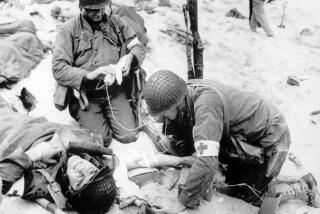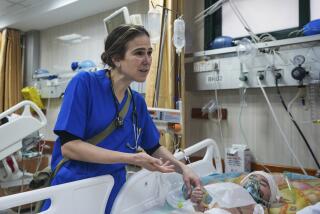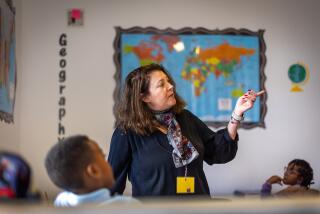Pupils Are Patient but Not Patients : Repetto Elementary School Children Get Hospital Tour
- Share via
They watched the little blips of their heartbeats on a monitor, and they peered into each other’s eyes and ears with the same kind of instruments their pediatricians use.
They used professional syringes to give “shots” to Raggedy Ann dolls, learned how to put a plaster cast on a finger and peered through microscopes in the Childrens Hospital of Los Angeles laboratory.
But the thing that puzzled the fifth-graders touring the hospital was the emergency room incubator: Why was it needed? And how in the world did they get a baby through those small round holes on the incubator’s side?
Emergency room nurse Julie Walker smiled.
“Sometimes,” said Walker, who is pregnant, “the baby just comes earlier than the mother expects, and the baby needs medical help.”
Then she showed how the incubator opens at one end and that the holes in the side are there so the doctor or nurse can reach in to touch the baby and care for it.
The children, 32 fifth-graders from Repetto Elementary School in Monterey Park, were the latest to participate in a program started by Childrens Hospital three years ago. Nurse-educator Judy Callan, coordinator of the program, estimated that about 700 schoolchildren have toured the hospital since the program began.
“We hope that after visiting Childrens (Hospital) they will not be so afraid of going to the hospital or doctor or of being sick,” Callan said. “We want them to better understand health care and to decrease their anxieties.
“We think the program is effective. It shows up in the feedback, which is very positive. They tell us the things they’ve learned. They know the equipment the doctor will use to examine them, and they are less afraid of needles after using them on the dolls. Being able to play that out helps them a lot. They still don’t like needles, but they are able to work it through.”
About a week before each tour Childrens Hospital staffers visit the classroom to show slides and brief the youngsters about some of the things they will see. The tour begins with refreshments and a talk by hospital personnel, including, on the Repetto School visit, two youthful doctors, Jill Kamon and Don Hensley, chief residents.
Kamon told of the years of study it takes to become a doctor and said “then you go to a hospital to learn how to take care of patients.” She asked if any of the children wanted to become doctors and about five raised their hands; several expressed a desire to be veterinarians.
Some of the children had been in a hospital: “My face got scratched.” “I broke my kneecap.” “I have asthma.”
Hensley sympathized with the latter. “I had asthma when I was younger,” he said. “It’s a terrible feeling not being able to breathe. But I outgrew it; that often happens.
“Were you afraid of the doctor when you were younger? I was. I used to run around the table when the doctor tried to give me a shot. We don’t use shots as much any more, except for very young children. We try to give liquids now, and at your age you’re old enough to swallow pills if you need antibiotics.”
The fifth-grade students admitted they were put off by people in white coats. “Most doctors here won’t look like doctors to you,” Hensley said. And the clothing that he and Kamon wore supported his statement.
Accompanied by teacher Lynette Schroedle and school nurse Janice Roman, the Repetto School class split into four groups as the demonstrations began, each moving from one area to another: the anesthesia machine, a table with instruments, sections for X-rays, for making casts for broken bones, and for the dreaded needles.
Sheri Szeles, patient activities specialist, explained about the shots: where on the body they are given, how to disinfect the area with alcohol, how to fill the syringe and tap it or shoot some of the liquid in the air to remove any air bubbles. She gave a Raggedy Andy doll a shot, then invited the children to do the same.
Then she asked, “What’s the worst part about getting a shot?” “Nothing,” one boy said. Case closed.
At the anesthesia machine, operating room nurse Jacqueline Visier, in surgical gown, cap and boots, explained how anesthetics are administered and how the patient is monitored. She put a round red patch on a child’s arm, attached electrodes and showed the children the heartbeat blinking across the screen. Visier gave each a parting gift: a surgical mask.
At the equipment table, nurses Elaine Goehner, assistant director of nursing education, and Mary Halverson, nurse-educator, explained the uses of the stethoscope, otoscope, ophthalmoscope and sphygmomanometer.
The youngsters listened to each other’s hearts, peered into classmates’ ears, shined the ophthalmoscope’s light in friends’ eyes and preferred to call the sphygmomanometer “the blood pressure tester.” They were entranced as Halverson used a hard rubber mallet to test their reflexes.
Plaster Cast Table
The plaster cast table was popular, too, especially when it came to wetting the cast in water. Physical therapist Heather Morse and nurse Karen Chinn of the Childrens Hospital’s rehabilitation center first showed X-rays of broken bones, then the steps in putting on a cast.
In the lab, medical technologist Nyassin Yawara discussed blood tests and urinalysis, showed vials of blood and blood-smeared slides, then let the class peer through microscopes.
The final stop of the tour was the Emergency Room, where nurse Walker told of the purposes and equipment in the various rooms: the orthopedic room with its lights for viewing X-rays and its splints and other materials; the “stitch” room with its disinfectants and needles and threads in varying sizes, and the major trauma room with its sophisticated apparatus.
In the stitch room, a child eyed the needles and threads--”just like your mother uses,” said Walker--with apprehension. “Does it hurt?” he asked. “Well,” Walker said, “they give you medicine so it won’t.”
In the major trauma room she talked about the fibrillators “for kids who have been in real bad accidents, who are very badly hurt,” the electrocardiogram machine, the incubator for babies and a warmer “to warm up a cold child rather quickly.”
As the tour ended, few of the children had gathered their thoughts about what they had seen. Cami Schempp, 10, was sticking to her goal of being a veterinarian, but Melinda Magdaleno, 11, was ambivalent about becoming a nurse.
“I want to be a nurse,” she said hesitantly, “but my grandmother is a nurse and she tells me not to because a nurse has to look at people’s insides.”
More to Read
Sign up for Essential California
The most important California stories and recommendations in your inbox every morning.
You may occasionally receive promotional content from the Los Angeles Times.










